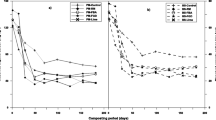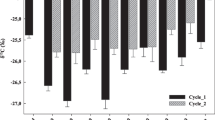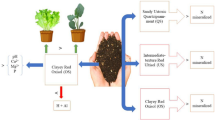Abstract
Increasing the consumer value of organic wastes through co-utilization or mixing is directly related to organic carbon (C) and nitrogen (N) mineralization when the mixture is used as a soil amendment. The objective of this study was to put forward a protocol that can be used to estimate the behavior of a mixture of biosolids and composts in a co-utilization program from the perspective of decomposability and release of plant available nitrogen (PAN) over time. Published literature suggested that the components of such mixtures would decompose in similar manner whether alone or in combination, and that net N immobilization characteristics of components with high C:N ratios could be overcome. Using the proper ratio of the components was essential to the development of a soil amendment which was more valuable than its components. Three mixtures for co-utilization of organic wastes were assessed using the computer simulation model, DECOMPOSITION. Municipal biosolids was mixed with paper mill sludge, leaf litter, and municipal solid waste (MSW) compost. Weather at Baltimore, MD, was selected for these simulations, with mixtures being applied in April. In each case a ratio was found to make a product with good N availability, but each mixture was sufficiently decomposable to limit its ability to increase soil organic matter (OM). The organic wastes most resistant to decomposition, very stable composts, were evaluated for potential to increase soil organic matter. Simulation of very stable compost decomposition showed that they would increase soil organic matter if applied annually for an extended period. These composts were also a good source of PAN after several years of application to soil.
Access this chapter
Tax calculation will be finalised at checkout
Purchases are for personal use only
Preview
Unable to display preview. Download preview PDF.
Similar content being viewed by others
References
Agbim NN, Sabey BR & Markstrom DC (1977) Land application of sewage sludge V. Carbon dioxide production as influenced by sewage sludge and wood waste mixtures. J. Environ. Qual. 6:446–451.
Blackmer AM & Green CJ (1995) Nitrogen turnover by sequential immobilization and mineralization during residue decomposition in soils. Soil Sci. Soc. Amer. J. 59:1052–1058.
Briones MJI & Ineson P (1996) Decomposition of Eucalyptus leaves in litter mixtures. Soil Biol. Biochem. 28:1381–1388.
Clark MD, Gilmour JT & Gale PM (1988) Computer simulations of decomposition and net N mineralization for land applied papermill sludge. Proceedings 1988 TAPPI Environmental Conference, Charleston, SC.
Cortez J, Denard JM, Bottner P & Monrozier LJ (1996) Decomposition of Mediterranean leaf litters: A microcosm experiment investigating relationships between decomposition rates and litter quality. Soil Biol. Bioch. 28:443–452.
Gilmour CM, Broadbent FE & Beck SM (1977) Chapter 7: Recycling carbon and nitrogen through land disposal of various wastes. In: Elliot LF & Stevenson FM (Eds) Soils for Management of Organic Wastes and Waste Waters. Soil Sci. Soc. Amer.
Gilmour JT, Clark MD & Sigua G. (1985) Estimating net nitrogen mineralization from carbon dioxide evolution. Soil Sci. Soc. Amer. J. 49:1398–1402.
Gilmour JT, Clark MD & Daniel SM (1996a) Predicting long-term decomposition of biosolids with a seven day test. J. Environ. Qual. 25:766–770.
Gilmour JT, Clark MD & Roman F (1996b) Decomposition of biosolids in a disposal site soil. J. Environ. Qual. 25.
Hamaker JW (1966) Mathematical prediction of cumulative levels of pesticides in soil. In: Gould RF (Ed) Organic Pesticides in the Environment. Advances in Chemistry Series 60:122–131.
Hadas A & Portnoy A (1994) Nitrogen and carbon mineralization rates of composted manures incubated in soil. J. Environ. Qual. 23:1184–1189.
Hanks RJ & Ashcroft GL (1980) Applied Soil Physics, p. 44. Springer-Verlag, New York.
He X, Logan TJ & Traina SJ (1995) Physical and chemical characteristics of selected U.S. municipal solid waste composts. J. Environ. Qual. 24:543–552.
Heckman JR & Kluchinski D (1996) Chemical composition of municipal leaf waste and hand-collected urban leaf litter. J. Environ. Qual. 25:355–362.
Henry CL & Harrison RB (1996) Compost fractions in compost and compost maturity tests. In: Magdoff FR, Tabatabai MA & Hanlon EA Jr. (Eds) Soil Organic Matter: Analysis and Interpretation. Soil Science Society of America Special Publication No. 46:51–67. Madison, WI.
Honeycutt CW, Zibilske LM & Clampham WM (1988) Heat units for describing carbon mineralization and predicting net N mineralization. Soil Sci. Soc. Amer. J. 52:1346–1350.
Insam H (1990) Are the microbial biomass and basal respiration governed by climatic regime? Soil Biol. Biochem. 22:525–532.
Jenkinson DS & Rayner JH (1977) The turnover of soil organic matter in some of the Rothamsted classical experiments. Soil Sci. 123:298–305.
Keeney DR & Nelson DW (1982) Nitrogen — inorganic forms. In: Page AL et al. (Eds) Methods of soil analysis. Part 2. 2nd ed. Agron. Monograph No. 9:643–698. Am. Soc. Agron. and Soil Sci. Soc. Amer., Madison, WI.
Ladd JN, Oades JM & Amato M (1981) Microbial biomass formed from 14C and 15N-labelled plant material decomposing in soils in the field. Soil Biol. Biochem. 13:119–126.
Molina JAE, Hadas & Clapp, CE (1990) Computer simulation of nitrogen turnover in soil and priming effect. Soil Biol. Biochem. 22:349–353.
Moorhead KK, Graetz DA & Reddy KR (1987) Decomposition of fresh and anaerobically digested plant biomass in soil. J. Environ. Qual. 16:25–28.
Nelson DW & Sommers LE (1982) Total carbon, organic carbon, and organic matter. In: Page AL et al. (Eds) Methods of soil analysis. Part 2. 2nded. Agron. Monograph No. 9:539–557. Am. Soc. Agron. and Soil Sci. Soc. Amer., Madison, WI.
Paul EA & Van Veen JA (1978) The use of tracers to determine the dynamic nature of organic matter. Trans. Int. Congr. Soil Sci. 3:61–102.
Sabey BR, Agbim NN & Markstrom DC (1975) Land application of sewage sludge: III. Nitrate accumulation and wheat growth resulting from addition of sewage sludge and wood wastes to soils. J. Environ. Qual. 4:388–393.
Sikora LJ, Cambardella CA, Yakovchenko V & Doran JW (1996) Assessing soil quality by testing soil organic matter. In: Magdoff FR, Tabatabai MA & Hanlon EA Jr. (Eds) Soil Organic Matter: Analysis and Interpretation. Soil Science Society of America Special Publication No. 46:41–50. Madison, WI.
Sommers LE, Gilmour CM, Wildung RE & Beck SM (1980) Chapter 3: The effect of water potential on decomposition processes in soil. In: Parr JF et al. (Eds) Water Potential Relationships in Soil Microbiology. Soil Sci. Soc. Amer., Madison, WI.
Tester CF, Sikora LJ, Taylor JM & Parr JF (1977) Decomposition of sewage sludge compost in soil: I Carbon and nitrogen transformations. J. Environ. Qual. 6:459–463.
Tester CF, Sikora LJ, Taylor JM & Parr JF (1979) Decomposition of sewage sludge compost in soil III: Carbon, nitrogen and phosphorus transformations in different sized fractions. J. Environ. Qual. 8:79–82.
Zibilske LM (1987) Dynamics of nitrogen and carbon in soil during papermill sludge decomposition. Soil Sci. 143:26–33.
Zibilske LM (1994) Carbon mineralization. In: Mickelson SHd.) Methods of Soil Analysis. Part 2. Microbiological and Biochemical Properties. Soil Sci. Soc. Amer. Book Series No. 5:835–863. Soil Sci. Soc. Amer., Madison, WI.
Author information
Authors and Affiliations
Editor information
Editors and Affiliations
Rights and permissions
Copyright information
© 1998 Springer Science+Business Media Dordrecht
About this chapter
Cite this chapter
Gilmour, J.T. (1998). Carbon and Nitrogen Mineralization During Co-Utilization of Biosolids and Composts. In: Brown, S., Angle, J.S., Jacobs, L. (eds) Beneficial Co-Utilization of Agricultural, Municipal and Industrial by-Products. Springer, Dordrecht. https://doi.org/10.1007/978-94-011-5068-2_8
Download citation
DOI: https://doi.org/10.1007/978-94-011-5068-2_8
Publisher Name: Springer, Dordrecht
Print ISBN: 978-94-010-6128-5
Online ISBN: 978-94-011-5068-2
eBook Packages: Springer Book Archive




